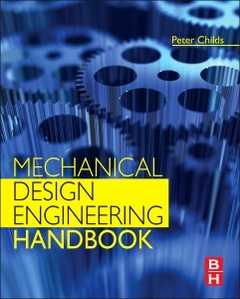Description
Mechanical Design Engineering Handbook
Author: Childs Peter
Language: English
Subject for Mechanical Design Engineering Handbook:
Keywords
Actuators; Advantage; AGMA; Analysis; Arrangement; Assurance; Axial; Band; Bearing; Bearings; Belleville; Belt; Bending; Bevel; Bolt; Boundary; Brainstorming; Brake; Bush; Chain; Clutch; Compression; Compressor; Connection; Construction; Contact; Control; Creative; Creativity; Customer; Deflection; Deployment; Design; Disc; Drive; Drives; Drum; Dynamic; Dynamics; Element; Energy; Engine; Engineering; Epicyclic; Equation; Evaluation; Extension; Failure; Fastener; Fasteners; Fastening; Fatigue; Fi
Publication date: 10-2018
856 p. · 19x23.3 cm · Paperback
Replaced by new edition: Access to the new edition.
Publication date: 09-2013
856 p. · 19x23.3 cm · Hardback
Replaced by new edition: Access to the new edition.
Description
/li>Contents
/li>Readership
/li>Biography
/li>Comment
/li>
Mechanical Design Engineering Handbook is a straight-talking and forward-thinking reference covering the design, specification, selection, use and integration of machine elements fundamental to a wide range of engineering applications.
Develop or refresh your mechanical design skills in the areas of bearings, shafts, gears, seals, belts and chains, clutches and brakes, springs, fasteners, pneumatics and hydraulics, amongst other core mechanical elements, and dip in for principles, data and calculations as needed to inform and evaluate your on-the-job decisions.
Covering the full spectrum of common mechanical and machine components that act as building blocks in the design of mechanical devices, Mechanical Design Engineering Handbook also includes worked design scenarios and essential background on design methodology to help you get started with a problem and repeat selection processes with successful results time and time again.
This practical handbook will make an ideal shelf reference for those working in mechanical design across a variety of industries and a valuable learning resource for advanced students undertaking engineering design modules and projects as part of broader mechanical, aerospace, automotive and manufacturing programs.
1. Design2. Specification3. Ideation4. Machine elements5. Journal bearings6.Rolling element bearings7. Shafts8. Gears9. Spur and helical gear stressing10. Bevel gears11. Worm gears12. Belt and chain drives13. Clutches and brakes14. Seals15. Springs16. Fastening and power screws17. Wire rope18. Pneumatics and hydraulics19. Engineering tolerancing
Primary audience: Professional engineers involved in mechanical and machine design, including those working within automotive, aerospace and related mechanical industries.
Secondary audience: Advanced students and graduates undertaking modules in design as part of mechanical, automotive and aerospace degree programs.
- Clear, concise text explains key component technology, with step-by-step procedures, fully worked design scenarios, component images and cross-sectional line drawings all incorporated for ease of understanding
- Provides essential data, equations and interactive ancillaries, including calculation spreadsheets, to inform decision making, design evaluation and incorporation of components into overall designs
- Design procedures and methods covered include references to national and international standards where appropriate




